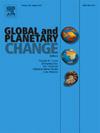New Sea-ice biomarker data from Bering-Chukchi Sea surface sediments and its significance for pan-Arctic proxy-based sea-ice reconstruction
IF 4
1区 地球科学
Q1 GEOGRAPHY, PHYSICAL
引用次数: 0
Abstract
Sea ice is an essential component in polar regions and plays an important role in global climate changes. Knowing sea-ice variabilities on long-term time scales is critical to understand the rapid sea-ice decline in recent decades and to predict future Arctic changes. In this study, a suite of biomarkers including highly branched isoprenoids (IP25 and HBI III (Z)) and sterols (brassicasterol and dinosterol) were measured in 55 surface sediments from the Bering-Chukchi Sea to central Arctic Ocean transect. PIP25 indices were calculated with sea-ice biomarker IP25 and phytoplankton biomarkers (brassicasterol, dinosterol and HBI III (Z)). The new data were combined with published data (n = 875) to complete the pan-Arctic dataset of biomarkers (n = 1062) in surface sediments. The compiled extended total data in general support previous pan-Arctic PIP25 studies and by this the reliability of the PIP25 approach for (paleo) sea-ice reconstructions. Furthermore, this study provides an extended basis for semi-quantitative paleo-sea-ice reconstruction in different regions of the Arctic Ocean. Phytoplankton biomarkers HBI III (Z) display highest values near the winter sea ice (WSI) edge in the pan-Arctic, reflecting the ice-edge conditions. PIIIIP25 show significant correlations with satellite spring/summer and autumn sea-ice concentration in the Pacific Sector of the pan-Arctic dataset (Bering-Chukchi Sea shelves, Chukchi Borderland and Canada Basin), and with spring/autumn sea-ice concentration in the Atlantic sector of the pan-Arctic dataset (Fram Strait, East Greenland shelf and Barents Sea). PIIIIP25 index seems to be reliable to reconstruct the paleo-sea-ice conditions in the Pan-Arctic, as well as PBIP25 and PDIP25 (using brassicasterol and dinosterol as phytoplankton biomarker, respectively). Furthermore, regional calibrations of comprehensive biomarker and PIP25 datasets against known sea-ice conditions would add further confidence in their application for paleo-sea-ice reconstruction. Based on our extended HBI III dataset we did not find that the HBI TR25 index was a reliable proxy for phytoplankton spring blooms on pan-Arctic scales. Certainly, deciphering the origin of certain biomarkers (e.g. HBI III (Z) and (E)) is still crucial for their application in further validation of PIP25 and TR25 indices application.
来自白令-楚科奇海表层沉积物的新海冰生物标志物数据及其对泛北极代用海冰重建的意义
海冰是极地地区的重要组成部分,在全球气候变化中发挥着重要作用。了解海冰在长期时间尺度上的变化对于理解近几十年来海冰的迅速减少和预测未来北极的变化至关重要。在这项研究中,测量了白令-楚科奇海至北冰洋中部横断面 55 个表层沉积物中的一系列生物标志物,包括高支链异戊烯(IP25 和 HBI III (Z))和甾醇(黄铜甾醇和地诺醇)。PIP25 指数是用海冰生物标志物 IP25 和浮游植物生物标志物(黄铜睾酮醇、二睾酮醇和 HBI III (Z))计算得出的。新数据与已公布的数据(n = 875)相结合,完成了泛北极表层沉积物生物标志物数据集(n = 1062)。汇编的扩展总数据总体上支持了之前的泛北极 PIP25 研究,从而证明了 PIP25 方法用于(古)海冰重建的可靠性。此外,这项研究还为北冰洋不同区域的半定量古海冰重建提供了一个扩展基础。浮游植物生物标志物 HBI III(Z)在泛北极冬季海冰(WSI)边缘附近显示出最高值,反映了冰缘条件。PIIIIP25 与泛北极数据集太平洋区(白令-楚科奇海大陆架、楚科奇边疆区和加拿大海盆)卫星春/夏和秋季海冰浓度有明显相关性,与泛北极数据集大西洋区(弗拉姆海峡、东格陵兰大陆架和巴伦支海)卫星春/秋季海冰浓度有明显相关性。PIIIIP25 指数以及 PBIP25 和 PDIP25(分别使用黄铜睾醇和二酮醇作为浮游植物生物标志物)似乎都能可靠地重建泛北极地区的古海冰状况。此外,根据已知海冰条件对综合生物标志物和 PIP25 数据集进行区域校准,将进一步增强它们在古海冰重建中的应用信心。根据我们扩展的 HBI III 数据集,我们没有发现 HBI TR25 指数是泛北极范围浮游植物春季繁殖的可靠替代指标。当然,破译某些生物标志物(如 HBI III (Z)和 (E))的来源对于进一步验证 PIP25 和 TR25 指数的应用仍然至关重要。
本文章由计算机程序翻译,如有差异,请以英文原文为准。
求助全文
约1分钟内获得全文
求助全文
来源期刊

Global and Planetary Change
地学天文-地球科学综合
CiteScore
7.40
自引率
10.30%
发文量
226
审稿时长
63 days
期刊介绍:
The objective of the journal Global and Planetary Change is to provide a multi-disciplinary overview of the processes taking place in the Earth System and involved in planetary change over time. The journal focuses on records of the past and current state of the earth system, and future scenarios , and their link to global environmental change. Regional or process-oriented studies are welcome if they discuss global implications. Topics include, but are not limited to, changes in the dynamics and composition of the atmosphere, oceans and cryosphere, as well as climate change, sea level variation, observations/modelling of Earth processes from deep to (near-)surface and their coupling, global ecology, biogeography and the resilience/thresholds in ecosystems.
Key criteria for the consideration of manuscripts are (a) the relevance for the global scientific community and/or (b) the wider implications for global scale problems, preferably combined with (c) having a significance beyond a single discipline. A clear focus on key processes associated with planetary scale change is strongly encouraged.
Manuscripts can be submitted as either research contributions or as a review article. Every effort should be made towards the presentation of research outcomes in an understandable way for a broad readership.
 求助内容:
求助内容: 应助结果提醒方式:
应助结果提醒方式:


